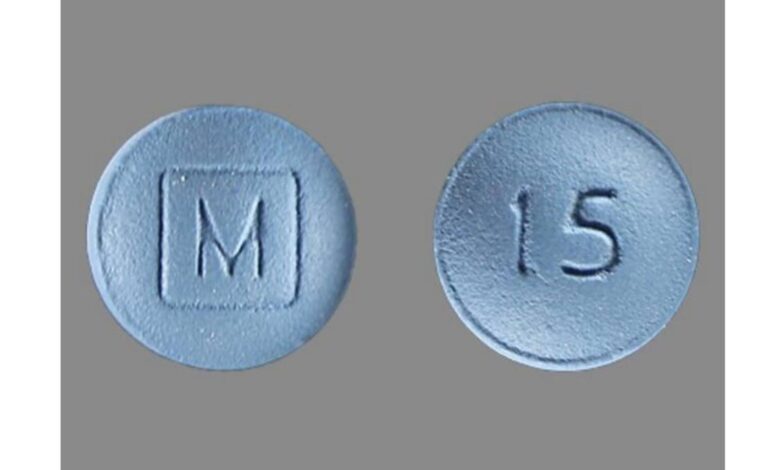What Blue Pill Has M On One Side And 15 On The Other

What Blue Pill Has M On One Side And 15 On The Other?
The blue round pill with the imprint 15 M has been identified as Morphine Sulfate Extended-Release 15 mg supplied by Mallinckrodt Pharmaceuticals. Morphine is in a class of medications called opiate (narcotic) analgesics. It works by changing the way the brain and nervous system respond to pain.
M 15 blue pill (morphine) is a class A, schedule 2 drug. Schedule 2 drugs and substances have a high potential for abuse. They differ from Schedule I drugs in that they do have a currently accepted medical use in treatment in the U.S. or a currently accepted medical use with severe restrictions.
Why is the M 15 blue pill prescribed?
M 15 blue pill is used to relieve moderate to severe pain. Morphine extended-release tablets and capsules are only used to relieve severe (around-the-clock) pain that cannot be controlled by the use of other pain medications. Morphine extended-release tablets and capsules should not be used to treat pain that can be controlled by medication that is taken as needed.
How should M 15 blue pill be used?
Follow the directions on your prescription label carefully, and ask your doctor or pharmacist to explain any part you do not understand. If you are taking the extended-release tablets (M 15 blue pill), swallow them one at a time with plenty of water. Swallow the extended-release tablets right after putting it in your mouth. Do not presoak, wet, or lick the extended-release tablets before you put them in your mouth.
Your doctor may start you on a low dose of morphine and gradually increase your dose until your pain is controlled. Your doctor may adjust your dose at any time during your treatment if your pain is not controlled. If you feel that your pain is not controlled, call your doctor. Do not change the dose of your medication without talking to your doctor.
Do not stop taking M 15 blue pill without talking to your doctor. Your doctor may decrease your dose gradually. If you suddenly stop taking morphine, you may experience withdrawal symptoms such as restlessness; teary eyes; runny nose; yawning; irritability; anxiety; sweating; difficulty falling asleep or staying asleep; chills; back, muscle, or joint pain; nausea; vomiting; loss of appetite; diarrhea; stomach cramps; weakness; fast heartbeat; or fast breathing.
What side effects can M 15 blue pill cause?
Morphine may cause side effects. Tell your doctor if any of these symptoms are severe or do not go away:
- drowsiness
- stomach pain and cramps
- dry mouth
- headache
- nervousness
- mood changes
- small pupils (black circles in the middle of the eyes)
- difficulty urinating or pain when urinating
Some side effects can be serious. If you experience any of the following symptoms, call your doctor immediately:
- blue or purple color to the skin
- changes in heartbeat
- agitation, hallucinations (seeing things or hearing voices that do not exist), fever, sweating, confusion, fast heartbeat, shivering, severe muscle stiffness or twitching, loss of coordination, nausea, vomiting, or diarrhea
- nausea, vomiting, loss of appetite, weakness, or dizziness
- inability to get or keep an erection
- irregular menstruation
- decreased sexual desire
- seizures
- extreme drowsiness
- fainting
- chest pain
- fever
- hives
- rash
- itching
- swelling of the eyes, face, mouth, lips or throat
- hoarseness
- difficulty breathing or swallowing
Morphine may cause other side effects. Call your doctor if you have any unusual problems while you are taking this medication.
M 15 blue Morphine pill Safety Information
Morphine may be habit forming, especially with prolonged use. Take morphine exactly as directed. Do not take more of it, take it more often, or take it in a different way than directed by your doctor. While you are taking morphine, discuss with your healthcare provider your pain treatment goals, length of treatment, and other ways to manage your pain. Tell your doctor if you or anyone in your family drinks or has ever drunk large amounts of alcohol, uses or has ever used street drugs, or has overused prescription medications, or has had an overdose, or if you have or have ever had depression or another mental illness. There is a greater risk that you will overuse morphine if you have or have ever had any of these conditions. Talk to your healthcare provider immediately and ask for guidance if you think that you have an opioid addiction or call the U.S. Substance Abuse and Mental Health Services Administration (SAMHSA) National Helpline at 1-800-662-HELP.
Morphine may cause serious or life-threatening breathing problems, especially during the first 24 to 72 hours of your treatment and any time your dose is increased. Your doctor will monitor you carefully during your treatment. Your doctor will adjust your dose carefully to control your pain and decrease the risk that you will experience serious breathing problems. Tell your doctor if you have or have ever had slowed breathing or asthma. Your doctor may tell you not to take morphine. Also tell your doctor if you have or have ever had lung disease such as chronic obstructive pulmonary disease (COPD; a group of lung diseases that includes chronic bronchitis and emphysema), a head injury, a brain tumor, or any condition that increases the amount of pressure in your brain. The risk that you will develop breathing problems may be higher if you are an older adult or are weakened or malnourished due to disease. If you experience any of the following symptoms, call your doctor immediately or get emergency medical treatment: slowed breathing, long pauses between breaths, or shortness of breath.
Taking certain other medications during your treatment with morphine may increase the risk that you will experience breathing problems or other serious, life-threatening breathing problems, sedation, or coma. Tell your doctor if you are taking or plan to take any of the following medications: benzodiazepines such as alprazolam (Xanax), diazepam (Diastat, Valium), estazolam, flurazepam, lorazepam (Ativan), and triazolam (Halcion); cimetidine (Tagamet); other narcotic pain medications; medications for mental illness or nausea; muscle relaxants; sedatives; sleeping pills; or tranquilizers. Your doctor may need to change the dosages of your medications and will monitor you carefully. If you take morphine with any of these medications and you develop any of the following symptoms, call your doctor immediately or seek emergency medical care: unusual dizziness, lightheadedness, extreme sleepiness, slowed or difficult breathing, or unresponsiveness. Be sure that your caregiver or family members know which symptoms may be serious so they can call the doctor or emergency medical care if you are unable to seek treatment on your own.
Drinking alcohol, taking prescription or nonprescription medications that contain alcohol, or using street drugs during your treatment with morphine increases the risk that you will experience breathing problems or other serious, life-threatening side effects. If you are taking Avinza brand long-acting capsules, it is especially important that you do not drink any drinks that contain alcohol or take any prescription or nonprescription medications that contain alcohol. Alcohol may cause the morphine in Avinza brand long-acting capsules to be released in your body too quickly, causing serious health problems or death. Do not drink alcohol, take any prescription or nonprescription medications that contain alcohol, or use street drugs during your treatment with other morphine products.
Do not allow anyone else to take your medication. Morphine may harm or cause death to other people who take your medication, especially children. Keep morphine in a safe place so that no one else can take it accidentally or on purpose. Be especially careful to keep morphine out of the reach of children. Keep track of how many tablets, or capsules, or how much liquid is left so you will know if any medication is missing. Dispose of any unneeded morphine capsules, tablets, or liquid properly according to instructions. (See STORAGE and DISPOSAL.)
Swallow the extended-release tablets or capsules whole. Do not split, chew, dissolve, or crush them. If you swallow broken, chewed, crushed, or dissolved extended-release tablets or capsules, you may receive too much morphine at once instead of receiving the medication slowly over time. This may cause serious breathing problems or death. If you are unable to swallow the capsules whole, follow the instructions in the ”HOW should this medication be used?” section below to dissolve the capsule contents in applesauce.
Morphine oral solution (liquid) comes in three different concentrations (amount of medication contained in a given amount of solution). The solution with the highest concentration (100 mg/5 mL) should only be taken by people who are tolerant (used to the effects of the medication) to opioid medications. Each time you receive your medication, check to be sure that you receive the solution with the concentration prescribed by your doctor. Be sure that you know how much medication you should take and how to measure your dose.
Tell your doctor if you are pregnant or plan to become pregnant. If you take morphine regularly during your pregnancy, your baby may experience life-threatening withdrawal symptoms after birth. Tell your baby’s doctor right away if your baby experiences any of the following symptoms: irritability, hyperactivity, abnormal sleep, high-pitched cry, uncontrollable shaking of a part of the body, vomiting, diarrhea, or failure to gain weight.
Your doctor or pharmacist will give you the manufacturer’s patient information sheet (Medication Guide) when you begin treatment with morphine and each time you fill your prescription if a Medication Guide is available for the morphine product you are taking. Read the information carefully and ask your doctor or pharmacist if you have any questions. You can also visit the Food and Drug Administration (FDA) website (http://www.fda.gov/Drugs/DrugSafety/ucm085729.htm) or the manufacturer’s website to obtain the Medication Guide.





